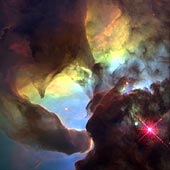|
COMETS EARTH JUPITER KUIPER BELT MARS MERCURY METEORITES NEPTUNE OORT CLOUD PLUTO SATURN SOLAR SYSTEM SPACE SUN URANUS VENUS ORDER PRINTS
PHOTO CATEGORIES SCIENCEVIEWS AMERICAN INDIAN AMPHIBIANS BIRDS BUGS FINE ART FOSSILS THE ISLANDS HISTORICAL PHOTOS MAMMALS OTHER PARKS PLANTS RELIGIOUS REPTILES SCIENCEVIEWS PRINTS
|
Related Documents
Download Options
This NASA Hubble Space Telescope (HST) image reveals a pair of one-half light-year long interstellar "twisters" -- eerie funnels and twisted-rope structures -- in the heart of the Lagoon Nebula (Messier 8) which lies 5,000 light-years away in the direction of the constellation Sagittarius. The central hot star, O Herschel 36 (lower right), is the primary source of the ionizing radiation for the brightest region in the nebula, called the Hourglass. Other hot stars, also present in the nebula, are ionizing the extended optical nebulosity. The ionizing radiation induces photo-evaporation of the surfaces of the clouds and drives away violent stellar winds tearing into the cool clouds. Analogous to the spectacular phenomena of Earth tornadoes, the large difference in temperature between the hot surface and cold interior of the clouds, combined with the pressure of starlight, may produce strong horizontal shear to twist the clouds into their tornado-like appearance. Though the spiral shapes suggest the clouds are "twisting", future observations will be needed, perhaps with Hubble's next generation instruments, with the spectroscopic capabilities of the Space Telescope Imaging Spectrograph (STIS) or the Near Infrared Camera and Multi-Object Spectrometer (NICMOS), to actually measure velocities. The Lagoon Nebula and nebulae in other galaxies are sites where new stars are being born from dusty molecular clouds. These regions are the "space laboratories" for the astronomers to study how stars form and the interactions between the winds from stars and the gas nearby. By studying the wealth of data revealed by HST, astronomers will understand better how stars form in the nebulae. These color-coded images are the combination of individual exposures taken in July and September, 1995 with Hubble's Wide Field and Planetary Camera 2 (WFPC2) through three narrow-band filters (red light -- ionized sulphur atoms, blue light -- double ionized oxygen atoms, green light -- ionized hydrogen). This work is based on public data retrieved from the HST Archive, cosmic-ray cleaned, calibrated and combined by Adeline Caulet (Space Telescope European Coordinating Facility, European Space Agency). Credit: A. Caulet (ST-ECF, ESA) and NASA |
